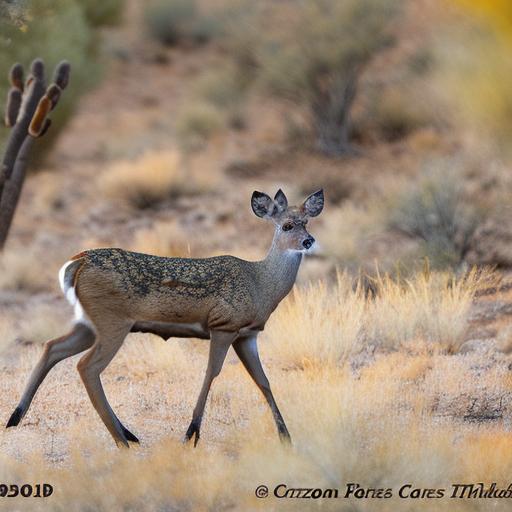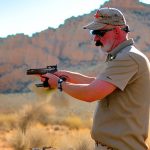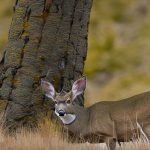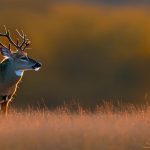Your cart is currently empty!

arizona coues deer hunting

Arizona is known for its diverse wildlife and beautiful landscapes, making it a popular destination for hunters from all over the world. One of the most sought-after game species in Arizona is the Coues deer. Coues deer hunting has gained popularity in recent years due to the challenge it presents and the unique experience it offers.
The Coues deer, also known as the “gray ghost,” is a subspecies of white-tailed deer that is native to Arizona and Mexico. It is named after Elliott Coues, a renowned American naturalist who first described the species in the late 1800s. What sets the Coues deer apart from other deer species is its small size and elusive nature. They are known for their exceptional eyesight and ability to blend into their surroundings, making them a challenging target for hunters.
Key Takeaways
- Coues deer hunting in Arizona requires essential hunting gear for a successful hunt.
- The best hunting seasons and time of day for Coues deer in Arizona are during the early morning and late afternoon in the fall and winter.
- Hunting techniques and strategies for Coues deer in Arizona include glassing, stalking, and calling.
- Scouting and locating Coues deer in Arizona requires knowledge of their habitat and behavior.
- Proper shot placement is crucial for Coues deer hunting in Arizona to ensure a humane kill.
The Habitat and Behavior of Coues Deer in Arizona
Coues deer are primarily found in the mountainous regions of Arizona, where they inhabit dense forests and rugged terrain. They are well adapted to this environment, with their small size allowing them to navigate through thick vegetation and their keen senses helping them detect predators from a distance.
During the summer months, Coues deer can be found at higher elevations, where they take advantage of the cooler temperatures and abundant food sources. As winter approaches, they migrate to lower elevations in search of milder weather and better forage. This seasonal movement can make it challenging for hunters to locate them, as they are constantly on the move.
Coues deer are primarily crepuscular animals, meaning they are most active during dawn and dusk. This behavior is believed to be an adaptation to avoid predators while still being able to find food and mates. As a result, many successful hunts take place during these low-light conditions when the deer are more likely to be on the move.
Essential Hunting Gear for a Successful Coues Deer Hunt
When it comes to Coues deer hunting, having the right gear can make all the difference. Here are some essential items that every hunter should consider:
1. Clothing: Camouflage clothing is a must for blending into the deer’s natural habitat. Opt for patterns that match the vegetation in the area you will be hunting in. Additionally, layering your clothing is important to regulate body temperature as temperatures can vary greatly throughout the day.
2. Weapon: The most common weapon used for Coues deer hunting is a rifle. Choose a caliber that is suitable for deer hunting and practice shooting at various distances to ensure accuracy. Additionally, a good quality scope is essential for spotting deer at long distances.
3. Accessories: A good pair of binoculars is crucial for spotting deer from a distance. Look for binoculars with a high magnification and good light transmission. Other accessories to consider include a range finder, a backpack for carrying gear, and a game cart for transporting harvested deer.
When choosing gear, it’s important to consider the specific conditions of your hunt. Factors such as terrain, weather, and hunting method should all be taken into account to ensure you have the right equipment for the job.
Best Hunting Seasons and Time of Day for Coues Deer in Arizona
The best time to hunt Coues deer in Arizona largely depends on the season and time of day. Here are some factors to consider:
1. Seasons: In Arizona, Coues deer hunting seasons typically run from August to January, with different units having different season dates. Early season hunts in August and September can be challenging due to the hot weather and limited movement of deer during daylight hours. However, these hunts can be rewarding if you are willing to put in the effort and scout early morning and late evening feeding areas.
Late season hunts in November and December can be more successful as the weather cools down and deer become more active. During this time, deer are focused on finding food sources to prepare for the winter months, making them more predictable in their movements.
2. Time of Day: As mentioned earlier, Coues deer are most active during dawn and dusk. This is when they are more likely to be feeding and moving around. Hunting during these low-light conditions can increase your chances of encountering deer. However, it’s important to note that hunting during the middle of the day can also be productive, especially during the rut when bucks are actively searching for mates.
It’s important to research the specific unit you will be hunting in and understand the regulations and season dates for that area. This will help you plan your hunt accordingly and increase your chances of success.
Hunting Techniques and Strategies for Coues Deer in Arizona
There are several hunting techniques and strategies that can be effective for Coues deer hunting in Arizona. Here are a few to consider:
1. Spot and Stalk: Spot and stalk is a popular technique for hunting Coues deer. This involves glassing an area from a vantage point, such as a hilltop or ridge, and using binoculars or a spotting scope to locate deer. Once a deer is spotted, the hunter can then plan a stalk to get within shooting range.
2. Still Hunting: Still hunting involves moving slowly and quietly through the woods, constantly scanning the surroundings for any signs of deer. This technique requires patience and careful observation, as Coues deer are known for their ability to blend into their environment.
3. Calling: During the rut, calling can be an effective technique for attracting bucks. Using a grunt call or rattling antlers can mimic the sounds of competing bucks and draw in curious deer. It’s important to practice calling techniques beforehand to ensure you sound realistic.
Choosing the right technique largely depends on the specific conditions of your hunt, as well as your personal preferences and skill level. It’s important to be adaptable and willing to try different techniques until you find what works best for you.
Tips for Scouting and Locating Coues Deer in Arizona
Scouting is a crucial part of any successful hunt, and Coues deer hunting is no exception. Here are some tips for scouting and locating Coues deer in Arizona:
1. Use Optics: Investing in a good pair of binoculars or a spotting scope is essential for scouting Coues deer. Spend time glassing areas from a distance, paying close attention to feeding areas, water sources, and travel corridors. Look for signs such as tracks, rubs, and scrapes that indicate deer activity.
2. Look for Fresh Sign: Fresh sign, such as fresh tracks or droppings, can indicate recent deer activity in the area. Pay attention to the size of the tracks, as larger tracks are likely from mature bucks.
3. Focus on Food Sources: Coues deer are primarily herbivores and rely on a variety of food sources throughout the year. Look for areas with abundant food sources such as oak trees, fruit-bearing shrubs, or agricultural fields. These areas are likely to attract deer and provide good hunting opportunities.
4. Consider Water Sources: Water is essential for deer survival, especially during the hot summer months. Look for natural water sources such as creeks, springs, or stock tanks. Setting up near these water sources can increase your chances of encountering deer.
5. Be Observant: Pay attention to the terrain and vegetation in the area you are scouting. Coues deer are masters of camouflage and can easily blend into their surroundings. Look for any movement or unusual shapes that may indicate the presence of deer.
Scouting should be an ongoing process leading up to your hunt. By familiarizing yourself with the area and understanding deer behavior, you can increase your chances of success on the day of the hunt.
The Importance of Proper Shot Placement for Coues Deer Hunting
Proper shot placement is crucial for ethical hunting and ensuring a quick and humane kill. Coues deer are relatively small animals, so it’s important to aim for vital organs to ensure a clean kill. Here are some tips for achieving proper shot placement on Coues deer:
1. Know the Anatomy: Familiarize yourself with the anatomy of a Coues deer to understand where vital organs are located. The heart and lungs are the primary targets, as a shot in this area will result in a quick kill.
2. Wait for the Right Shot: Patience is key when it comes to shot placement. Wait for the deer to present a broadside or quartering-away shot, as this will provide the best opportunity to hit vital organs. Avoid taking risky shots that may result in wounding the animal.
3. Aim for the High Shoulder: Aiming for the high shoulder can be an effective shot placement on Coues deer. This area is located just above the heart and lungs and can result in a quick kill by breaking the spine or shoulder.
4. Practice Shooting Positions: Practice shooting from various positions, such as standing, kneeling, or sitting, to prepare for different hunting scenarios. This will help you become more comfortable and accurate when taking shots in the field.
It’s important to remember that ethical hunting practices should always be followed. Take the time to ensure a clean and humane kill, and always respect the animal you are hunting.
Regulations and Licensing Requirements for Coues Deer Hunting in Arizona
Before embarking on a Coues deer hunt in Arizona, it’s important to familiarize yourself with the regulations and licensing requirements set forth by the Arizona Game and Fish Department (AZGFD). Here are some key points to consider:
1. Licensing: In order to hunt Coues deer in Arizona, you must possess a valid hunting license and a deer tag specific to the unit you will be hunting in. These tags are limited in number and are allocated through a lottery system. It’s important to apply for tags well in advance of the hunting season.
2. Bag Limits: The bag limit for Coues deer in Arizona is one deer per calendar year. This means that once you have harvested a deer, you are not allowed to harvest another until the following year.
3. Weapon Restrictions: Arizona allows hunting Coues deer with a variety of weapons, including rifles, muzzleloaders, and archery equipment. However, there may be specific regulations regarding caliber restrictions or archery equipment requirements, so it’s important to check the regulations for the unit you will be hunting in.
4. Reporting Requirements: After harvesting a Coues deer, hunters are required to report their harvest within 48 hours. This can be done online or by phone, and failure to report can result in penalties.
It’s important to thoroughly read and understand the regulations before your hunt to ensure compliance with the law. The AZGFD website provides detailed information on licensing requirements, season dates, and specific regulations for each unit.
Conservation Efforts and Management of Coues Deer in Arizona
Conservation efforts and responsible management practices are crucial for the long-term survival of Coues deer populations in Arizona. The Arizona Game and Fish Department works diligently to ensure sustainable hunting opportunities while also protecting the species. Here are some key conservation efforts and management practices in place for Coues deer:
1. Habitat Management: The AZGFD focuses on maintaining and improving habitat conditions for Coues deer by implementing various habitat management practices. This includes conducting prescribed burns, thinning vegetation, and creating water sources to enhance food availability and cover.
2. Population Monitoring: The AZGFD conducts regular population surveys to monitor Coues deer populations and assess their health and abundance. This information is used to set hunting season dates, bag limits, and other regulations to ensure sustainable hunting opportunities.
3. Research and Education: The AZGFD invests in research projects to better understand Coues deer behavior, habitat requirements, and population dynamics. This information is used to inform management decisions and educate hunters on responsible hunting practices.
4. Collaboration with Landowners: The AZGFD works closely with private landowners to promote responsible land management practices that benefit Coues deer populations. This includes providing technical assistance, habitat improvement grants, and incentives for landowners who participate in conservation programs.
It’s important for hunters to be aware of these conservation efforts and do their part to ensure the long-term sustainability of Coues deer populations. This includes practicing ethical hunting, reporting harvests, and supporting conservation organizations.
The Thrill of the Hunt: Personal Experiences of Coues Deer Hunting in Arizona
Coues deer hunting in Arizona offers a unique and thrilling experience for hunters. The combination of challenging terrain, elusive deer, and breathtaking landscapes creates an unforgettable adventure. Here are some personal anecdotes and experiences from hunters who have pursued Coues deer in Arizona:
1. Challenging Pursuit: Many hunters describe Coues deer hunting as one of the most challenging hunts they have ever experienced. The small size and elusive nature of the deer make them difficult to spot and even harder to get within shooting range. This challenge adds to the excitement and satisfaction of a successful hunt.
2. Breathtaking Landscapes: Arizona is known for its stunning landscapes, from towering mountains to vast deserts. Coues deer hunting allows hunters to immerse themselves in these beautiful surroundings while pursuing their quarry. The opportunity to witness a sunrise or sunset over the mountains while waiting for a deer is an experience that cannot be replicated.
3. Unforgettable Memories: Coues deer hunting often creates lasting memories for hunters. Whether it’s the thrill of spotting a buck from a distance, the adrenaline rush of a successful stalk, or the camaraderie shared with hunting partners, these experiences leave a lasting impression and create stories that are shared for years to come.
The thrill of the hunt is what draws many hunters to pursue Coues deer in Arizona. The combination of challenging conditions, breathtaking landscapes, and the opportunity to test one’s skills creates an experience that is truly unique.
Coues deer hunting in Arizona offers a challenging and rewarding experience for hunters. The small size and elusive nature of the deer make them a challenging target, while the diverse landscapes and breathtaking scenery create an unforgettable adventure. It’s important for hunters to practice ethical hunting practices and comply with regulations to ensure the long-term sustainability of Coues deer populations. By doing so, hunters can continue to enjoy the thrill of the hunt for years to come.
If you’re interested in Arizona Coues deer hunting, you might also want to check out this informative article on how to carry rabbits when hunting. It provides valuable tips and techniques for hunters who are looking to improve their skills in handling rabbits during a hunt. Whether you’re a beginner or an experienced hunter, this article offers practical advice that can enhance your hunting experience. So, if you’re ready to take your hunting game to the next level, be sure to give it a read! (source)
FAQs
What is a Coues deer?
Coues deer is a subspecies of the white-tailed deer found in Arizona, New Mexico, and Mexico. They are smaller in size and have a grayish-brown coat with a white underside.
When is the hunting season for Coues deer in Arizona?
The hunting season for Coues deer in Arizona usually starts in late December and runs through January.
What are the hunting regulations for Coues deer in Arizona?
Hunters are required to have a valid hunting license and a deer tag to hunt Coues deer in Arizona. The bag limit is one deer per year, and hunters are not allowed to use bait or dogs to hunt Coues deer.
What is the best time of day to hunt Coues deer?
Coues deer are most active during the early morning and late afternoon hours. Therefore, the best time to hunt them is during these times.
What is the recommended hunting gear for Coues deer hunting?
Hunters are recommended to use a rifle with a caliber of .243 or higher, binoculars, and a spotting scope for Coues deer hunting. They should also wear appropriate clothing and footwear for the terrain.
What is the success rate for Coues deer hunting in Arizona?
The success rate for Coues deer hunting in Arizona varies depending on the hunting location and the hunter’s skill level. However, the success rate is generally around 30-40%.

Herb has been a longtime lover of the outdoors. Whether it be hunting, camping, fishing or just getting outside to reset. Proud father and animal lover. Bourbon anyone?

by
Tags:
Comments

Categories
- Big Game Hunting (301)
- Deer (202)
- Reviews (3)
- Shooting (16)
- Slingshot (1)
- Small Game Hunting (42)
- Upland Hunting (126)
- Waterfowl Hunting (3)





Leave a Reply